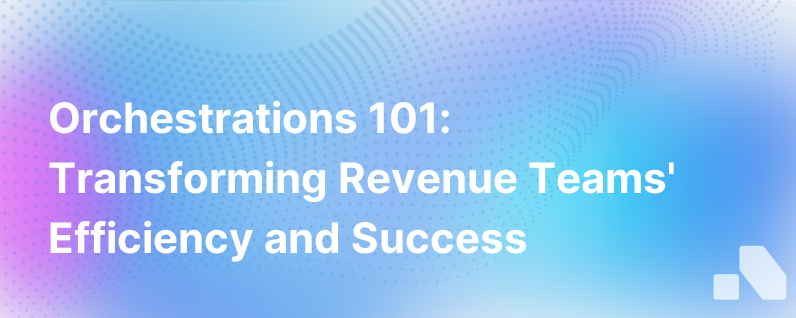Orchestrations 101 What They Are How They Work And How They Change The Game For Revenue Teams
Published on December 11, 2023 by David Zhang
In the world of B2B sales and marketing, finding the perfect symphony between different team attributes and actions is critical for driving revenue. Orchestrations are this symphony’s scores. This detailed guide is intended to break down what orchestrations are, how they work, and most importantly, how they are changing the game for revenue teams.
What are Orchestrations?
At its core, orchestrations in the business context refer to the strategic alignment and synchronization of sales, marketing, and customer success efforts to efficiently engage prospects and customers across their lifecycle. This alignment involves seamlessly coordinated activities—or plays—that aim to enhance customer experiences and drive revenue growth.
Unlike standalone sales or marketing strategies, orchestrations require that various parts of the organization participate in a cohesive and consistent manner. Orchestrations are about playing the long game, leveraging data and insights across the entire customer journey to create tailored interactions that resonate on a personal level.
How Do Orchestrations Work?
To fully understand the mechanics of orchestrations, we must explore their key components and the roles they play in this intricate process:
Data Analysis and Insights: This is the foundation of effective orchestrations. By analyzing customer data and behaviors, teams gain actionable insights. These insights become the basis for targeted campaigns, personalized messages, and timely engagements.
Connected Systems: Orchestrations rely on integrated technology systems. CRMs, marketing automation tools, data analytics platforms, and customer success software must communicate flawlessly. When data flows seamlessly, orchestrations can be executed in real time and are far more effective.
Customer Journey Mapping: Orchestrations demand an in-depth understanding of the customer journey. Each touchpoint is examined and optimized to ensure consistent and meaningful interactions that guide prospects toward conversion and customers toward loyalty.
Cross-Functional Collaboration: Different teams must work together towards a unified goal. Marketers might generate awareness and capture leads; sales teams then nurture these leads to close deals; customer success steps in for onboarding, retention, and upselling. Orchestrations require that all roles and activities are well-defined and coordinated.
Automated Workflows: Automating certain aspects of orchestrations, such as lead scoring or email campaigns, allows for timely actions without manual intervention. Workflows can trigger the next step in a customer's journey automatically.
How Orchestrations Change The Game For Revenue Teams
The paradigm shift towards orchestrations is redefining how revenue teams operate. Here’s how:
Streamlined Communications: Instead of bombarding customers with mismatched messages, orchestrations provide a strategic narrative throughout the customer journey. This elevates the quality of communication and fosters a stronger, clearer brand image.
Enhanced Personalization: Orchestrations enable highly personalized interactions based on customer data. No more generic email blasts; now, every touchpoint is crafted to resonate with the individual’s preferences, history, and predicted needs.
Increased Efficiency: By aligning multiple departments and automating aspects of the engagement process, orchestrations allow revenue teams to operate with increased efficiency. Actions are carried out swiftly, and handovers between teams are smooth and error-free.
Improved Customer Experiences: Orchestrations are meant to provide customers with seamless experiences. These positive interactions build trust and credibility, making customers feel valued and understood, which in turn leads to higher satisfaction and loyalty.
Data-Driven Decisions: Orchestrations thrive on data. This wealth of information guides strategic decisions, from content creation to sales pitches, ensuring that every move is informed by solid insights.
Scalability and Adaptability: As orchestrations are meticulously planned, they can be scaled up to handle growth and modified to adapt to changes in market conditions or customer behavior.
Measurable Outputs: With data at the forefront of orchestrations, tracking performance and ROI becomes simpler and more accurate. Revenue teams can easily measure the impact of their strategies and iterate for continuous improvement.
Increased Sales and Revenue: Ultimately, orchestrations are designed to drive sales and increase revenue. By ensuring that every interaction with a prospect or customer is optimized for conversion, revenue teams see more successful deals and upsells.
Conclusion
Orchestrations represent a fundamental evolution in the way that revenue teams approach their work. This strategy champions the alignment of different functional teams under a data-driven, customer-centered strategy, ensuring that every contact with a customer is harmonious and purposeful. In today’s hyper-competitive business environment, orchestrations provide the leverage that companies need to not only meet customer expectations but exceed them, thus securing their position and profitability in the marketplace.
For startups and established businesses alike, embracing orchestrations and mastering their intricacies could mark the difference between an organization that survives and one that thrives. It’s essential that companies invest in the right tools, technologies, and training to execute orchestrations effectively. By using AI platforms like Aomni that support ease in account research, competitive insights, and personalized sales content, you're already setting the stage for successful orchestration.